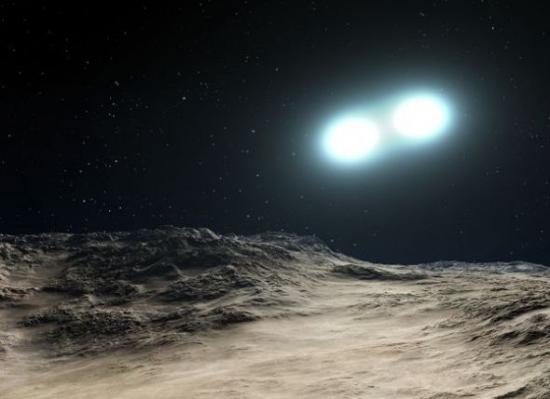据美国国家地理网站报道,科学家最近第一次在我们的银河系中心发现“吸血鬼”恒星,它们从邻近恒星吸取能量。

概念图,它显示的是两颗恒星合并在一起,形成一颗蓝离散星。

用绿色圆圈圈出的位于银河系膨胀区的可能的“吸血鬼”恒星。(图片由美国宇航局和欧洲航天局提供)
科学家曾在银河的其他部分发现这种名叫蓝离散星(blue stragglers)的“吸血鬼”恒星,它们的年龄显然滞后于其他恒星,它们明显更热、更年轻和更蓝。天文学家认为,这种蓝离散星之所以会如此年轻,是因为它们偷取了其他恒星的氢燃料,或许是通过碰撞吞噬了附近的恒星。这种“吸血鬼”恒星经常出现在密集的恒星簇里,这里的恒星从其他恒星获取能量的机会更多。现在科学家已经在银河系中心被气体笼罩、恒星密集的银河核球(银河系盘面中央的隆起区域)发现蓝离散星。
美国印地安那大学伯明顿分校和加州大学洛杉矶分校的天文学家威尔·克拉克森说:“长期以来,科学家一直猜测银河核球存在蓝离散星,但是没人知道那里有多少这种恒星。最终我们的研究将会找到这个问题的答案。”天文学家利用美国宇航局的哈勃太空望远镜观测银河核球内及其附近的18万颗恒星。该科研组发现42颗与众不同的蓝色恒星,它们显然比其他恒星更年轻。研究人员最终确定,这42颗恒星中有18到37颗是真正的蓝离散星,它们的年龄在大约100亿到110亿年之间。其余的蓝色恒星可能是位于银河核球内或以外区域的真正的年轻恒星。
也许这些蓝离散星并不是通过与其他恒星相撞和汲取额外的氢燃料形成的。相反,这些位于银河核球的蓝离散星可能是通过偷取它们的伴星的氢燃料形成的。这一过程可能发生在一颗恒星以双星系里的伴星为能量源时,或者三星系里的引力作用导致其中两颗恒星合并在一起时。克拉克森说:“关于蓝离散星是如何形成的问题,我们还有很多细节需要了解。在银河核球发现这种恒星,对改进它们的形成模式有帮助。”这些科学家5月25日在波士顿举行的美国天文学会会议上详细介绍了该发现。
生物探索推荐英文
"Vampire" Stars Found in Heart of Our Galaxy—A First
The stellar version of vampires—stars that drain life away from other stars—have been discovered for the first time in the heart of our Milky Way galaxy.
Called blue stragglers, these cannibal stars have been spotted in other parts of the Milky Way. They seem to lag in age next to the other stars with which they formed—appearing hotter, and thus younger and bluer.
Astronomers suspect blue stragglers look so youthful because they've stolen hydrogen fuel from other stars, perhaps after colliding into their victims.
These cannibal stars are routinely found in dense star clusters, where stars have many chances to feed off each other. Now, however, scientists have found blue stragglers in the Milky Way's galactic bulge, a dense region of stars and gas surrounding the galaxy's center.
"For a long time, it was suspected there were blue stragglers in the bulge, but no one knew how many there might be," said Will Clarkson, an astronomer at Indiana University Bloomington and the University of California, Los Angeles.
"At long last, we've shown they're there."
Milky Way Vampires Formed Differently?
Using NASA's Hubble Space Telescope, astronomers looked at 180,000 stars in and near the bulge. The team discovered 42 unusually blue stars that appeared much younger than the other stars.
From these 42 stars, researchers estimate that 18 to 37 of them are likely real blue stragglers that are about 10 billion to 11 billion years old. The remainder may be genuinely young stars in the bulge, or stars not actually in the bulge.
It's also possible the blue stragglers did not form by slamming into other stars and absorbing extra hydrogen fuel, as occurs in other parts of the universe.
Instead, the blue stragglers in the galactic bulge may have formed by ripping hydrogen off their companion stars. This possibly occurred either when one star fed off its partner in a two-star system, or perhaps after gravitational interactions in a triple-star system had caused two of its members to merge into one.
"There's still a lot we don't know about the details of how blue stragglers form," Clarkson said. "Finding them in the bulge provides another set of constraints that can help refine models of their formation."
Vampire-star findings presented May 25 at an American Astronomical Society meeting in Boston.







